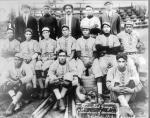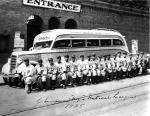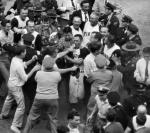Chapter One: Baseball in Pittsburgh
Though it has always been one of the smallest cities with a major league team, Pittsburgh is an enormous baseball town with a superb record of achievement. Several times during the twentieth century, the Pittsburgh Pirates dominated National League play. And the city was also home to two of the game's most fabled black nines: the
At one time or another, these three teams' flannels spread across the backs of Hall of Famers like
Despite its size, Pittsburgh was certainly ripe for the game. In the late nineteenth century, the region's natural resources and new technologies helped turn Pittsburgh into the mecca of the nation's steel industry, and the city grew dramatically with workers in search of jobs. Blacks migrated from the South, and Irish, Polish, German, and other European immigrants flocked to the city on a wave of high economic hopes. Soon, mills began forming baseball teams to help foster morale among their workers. For most, the game was pure recreation. But for talented athletes like Honus Wagner and Josh Gibson, whose families had come to Pittsburgh looking for work, baseball became a vehicle for a better life beyond the mills.
Pittsburgh first became a big league city when the Alleghenies, a local professional club made up of the city's best players, joined five other teams to form the American Association in 1882. These Alleghenies actually mark the second effort to establish professional baseball in Pittsburgh. The city's first pro ball club, also called the Alleghenies, began play at Union Park in 1876. Despite gaining membership to the International League the following season, the club folded in 1878, unable to compete with the strong, local independent squads like the East Liberty Stars or the Olympics, which were better-rooted in the Pittsburgh neighborhoods and workplaces.
The second Alleghenies team found that they could compete at the highest levels. In 1887, the team transferred to the National League, where it has been ever since. Accused of stealing a rival player's services in 1891, the Alleghenies suddenly found themselves referred to as the "Pirates," a much bolder
The 1902 team won the pennant by a shocking 27-1/2 games, still a Major league record. In 1903, the Pirates represented the National League in the modern era's
Another new technology became part of the game in 1921 when Pittsburgh's
Thrilling as they could be, the Pirates were not the only game in town. An all-black sandlot team begun in 1900 by black steelworkers and Homestead, PA, natives evolved into the powerful Homestead Grays. Led by former outfielder-turned-team owner Cum Posey, the Grays plowed through all comers, successfully barnstorming against the region's black and white competition alike. By the early 1920s, Posey was supplementing his core of strong local talent with the best players he could buy - players like Oscar Charleston, Cool Papa Bell, Judy Johnson, and pitcher Smokey Joe Williams. In 1930, he found his greatest star - heavy-hitting catcher Josh Gibson, almost under his own nose in the Pittsburgh sandlots.
Posey acquired more than the Grays' signature star in 1930. For the first time, he also faced Gus Greenlee, a slick operator who ran the North Side numbers game, an illegal lottery popular in Pittsburgh's black neighborhoods. Greenlee took control of the sandlot Pittsburgh Crawfords and turned them into one of the greatest black teams ever assembled, winning Negro National League titles in 1935 and 1936. As an owner with deep pockets, Greenlee willingly paid to bring in stars from other parts of the country, stars like Satchel Paige. Closer to home, he used his thick wallet to lure the powerful core of Charleston, Johnson and Gibson away from the Grays. And though few black clubs had their own ball parks, Greenlee even built the team a stadium.
Greenlee's entry into the game marked the beginning of the reign of African-American racketeers over black baseball. With so few avenues of opportunity available to them especially during the bleak years of the Great Depression, many entrepreneurial men and women followed the examples of those around them, and turned to gambling and other illegal activities for steady returns on their dollars. "They would have been steel tycoons, Wall Street brokers, auto moguls," wrote novelist and essayist Richard Wright, "had they been white." But they weren't. Many black numbers' bankers, like Greenlee, put profits back into their own communities, investing in small businesses, supporting charities and churches, contributing to politicians, and making never-to-be-repaid personal loans to help see folks through times of need. For men like Greenlee, baseball and other sports were both revenue sources and ways to enhance their reputations.
To counter Greenlee and fatten the Grays' bankroll, Posey brought in a numbers king and financial partner of his own, a man named Sonnyman Jackson. In the end, Posey and Jackson simply outlasted Greenlee, who folded the Crawfords in the summer of 1937 when he lost nine players to the Dominican Republic. Once again, the Grays were poised to rule black baseball in Pittsburgh and beyond. Playing in Forbes Field when the Pirates were away, the Grays won the next nine Negro National League championships, a streak of excellence unequalled by any other franchise in any other American sport and an enormous source of pride to Pittsburgh's black community. Once Jackie Robinson broke the Major league color line in 1947, however, the Grays quickly faded from the scene.
While the Grays and Crawfords were winning games and fans, the Pirates experienced a stretch of lean years. But even without championships, there were high points: slugging outfielder Ralph Kiner set a record for seven consecutive home run titles in the late 1940s and early 1950s; in 1959, Harvey Haddix pitched one of the greatest games in history, tossing
Despite consistent heroics from Roberto Clemente, the rest of the 1960s was a lost decade for the Pirates. And while there were no more championship flags, there was plenty of talent. Willie Stargell, for instance, led the Pirates to world championships in 1971 and 1979, with divisional titles in between. By then the beloved Stargell, one of the most dynamic power hitters and team leaders of his day, was called "Pops" and the team was his "family." But the family exhibited serious signs of dysfunction after Stargell's retirement in 1982. A clubhouse drug scandal led to a 1985 federal court trial in Pittsburgh that implicated some thirty major leaguers, tarnishing not only the Pirates' image but the image of baseball, as well.
After 1979, the Pirates had one short burst of glory: a division title in 1991 on the sting of the "Killer B's" - Barry Bonds and Bobby Bonilla - before the new economics of baseball in the age of television caught up with the team. Because Pittsburgh remains one of the smallest cities in the Majors, it lacks the resources and media revenues that larger market teams have to aggressively pursue high-priced free agents. What the team did pursue aggressively was a new ballpark. In 2001, the Pirates vacated the cavernous dungeon of Three Rivers Stadium for its new home: the smaller, graceful, PNC Park.












